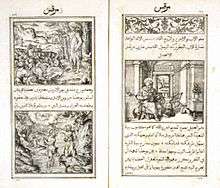Robert Granjon
Robert Granjon (1513-November 16, 1589/March 1590) was a French type designer and printer.[1] He worked in Paris, Lyon, Frankfurt, Antwerp, and Rome for various printers. He is best known for having introduced the typeface Civilité and for his italic type form, the design of which in modern days is used in Garamond Italic.
He worked in Lyon as a librarian, printer, and engraver of typefaces. He married the daughter of Bernard Salomon. The first book in his typeface, Civilité, was Dialogue de la vie et de la mort by Ringhieri (1557). The invention made such an impact that King Henry II, on December 26, 1557, gave him an exclusive privilege to use the type for ten years. Granjon's italic had a greater slant angle, slanted roman capitals, and reduced weight and rigor. These qualities and its contrasting thick and thin strokes gave it a dazzling appearance that made it difficult to read. It was nevertheless the main influence for italic type design until the Arrighi model was revived in 1920.
In 1578, he moved to Rome, where he worked on types for Oriental characters needed by the Catholic missionaries: Armenian (1579), Syriac (1580), Cyrillic (1582), and Arabic (1580-86). He collaborated with Giambattista Raimondi, the scientific director of the Stamperia Medicea Orientale, and Domenico Basa, the technical director of the Stamperia Vaticana, and contributed the earliest printed editions in certain Oriental languages.[2]
He also developed several important music founts, including one that became the most widely used music typeface until the middle of the eighteenth century. In Paris and Lyons printed several books of music.[3]
Some of the materials used by Granjon are preserved in the Plantin-Moretus Museum in Antwerp.
Printed books
.jpg)
- Alphabet, ou instruction Chrestienne pour les petis Enfans. Aveq plusieurs prieres, & sentences extraictes de la sainte Escriture, pour l'instructions des enfans, Lyon, Robert Granjon, 1560. Lyon, Robert Granjon, 1558. The text is entirely printed in a typeface conceived by Granjon and used for the first time in 1558.
- Alexandreidos Libri decem. Nunc primum in Gallia Gallicisque characteribus editi, Lyon, Robert Granjon, 1558 by Gautier de Châtillon. This is the first Latin text entirely printed in Civilité. The use of this font for a Latin text was probably planned to make the font more popular.
See also
- Galliard (typeface), typeface designed by Matthew Carter in 1978, based on Granjon’s design
Notes
- Vervliet, Hendrik D. L. (2018). Robert Granjon, letter-cutter (1513-1590): an oeuvre-catalogue (First ed.). New Castle: Oak Knoll Press. ISBN 9781584563761. Retrieved 2 July 2020.
- Rome Reborn: The Vatican Library & Renaissance Culture/ Orient to Rome
- Pogue, Samuel F. & Dobbins, Frank (2001). "Robert Granjon". In Root, Deane L. (ed.). The New Grove Dictionary of Music and Musicians. Oxford University Press.
References
- Maurits Sabbe, Marius Audin. Die Civilité-Schriften des Robert Granjon in Lyon: und die flämischen Drucker des 16. Jahrhunderts. Vol. 3 of Bibliotheca typographica, Bibliotheca Typographica, 1929.
- Hendrik D. L. Vervliet. The Palaeotypography of the French Renaissance. Leiden: Brill, 2008, p. 321 ff. ISBN 978-90-04-16982-1
External links
- Granjon® script family at www.linotype.com
- Romaine typeface, digitization of Granjon’s Ascendonica, designed by Aad van Dommelen in 2020
